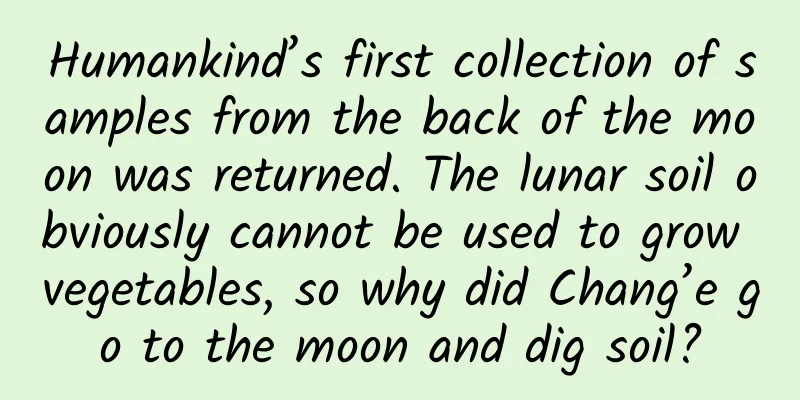Humankind’s first collection of samples from the back of the moon was returned. The lunar soil obviously cannot be used to grow vegetables, so why did Chang’e go to the moon and dig soil?

|
On June 2, 2024, Chang'e-6 landed at the pre-selected landing site in the South Pole-Aitken Basin on the far side of the moon, successfully completed the lunar soil sampling mission, and returned to Earth smoothly on June 25, 2024. It will also bring back approximately 2 kg of lunar far side samples, realizing the world's first lunar far side sampling return. Chang'e 6 successfully returned. Image source: CCTV News Channel So the question is, didn't Chang'e 5 already go to the moon and dig up lunar soil? After testing, it was found that the lunar soil was not suitable for growing vegetables... So why send Chang'e 6 to make another trip? In fact, this is by no means a superfluous move. Image from CCTV News Channel's report on Chang'e 5 Next, let’s briefly talk about the differences and research significance of lunar soil and Earth soil (not just growing vegetables), as well as the differences in the lunar soil obtained from the two Chang’e sampling missions. Differences between lunar soil and earth soil Although it contains the word "soil", if we want to expand "lunar soil" to understand it as "moon soil", it always feels strange and a bit "unworthy of the position". Grab a handful of earth soil, it is soft and sticky, and smell it up close, there is a "fragrance of soil". But (if you can) grab a handful of lunar soil, it is rough and prickly, and smell it up close, I'm afraid you will cough and sniffle on the spot. Why is this so? Because the production process of lunar soil and earth soil is very different. In the process of becoming soil, rocks on the earth first undergo weathering. Although "weathering" only mentions wind, weathering is not just wind erosion, but also includes rain erosion, glacier cutting, transportation and transfer, cracking caused by water accumulation in rock crevices and freezing and expansion, and chemical dissolution. During the weathering process, rocks are gradually broken down and ground into fine, moist particles and powder, forming clay minerals that are conducive to water retention. While participating in weathering, rainwater also gradually brings soluble mineral nutrients underground, forming layers at different depths. Living things benefit from the earth's soil and also contribute to it. They are nourished by the earth and return to the earth after death. Therefore, the earth's soil contains various minerals, organic matter and even tiny organisms, etc. It is a complex mixture. However, the moon has neither atmosphere nor water (there is water on the moon, but only in the permanent shadow areas at the poles, which may have been brought by comet impacts), and there is no life to speak of. Therefore, the moon cannot use any of the rich and varied soil-forming methods on Earth. The rocks on the moon can only be gradually broken by (micro)meteorite impacts and the temperature difference between day and night, or ultra-finely processed by the solar wind, ultraviolet rays and X-rays from the sun. The force of micrometeorite impacts can break the rock debris, and the high temperature brought by the impact can in turn re-sinter the debris, and the final lunar soil is more like rough, angular slag. Think about it, if you smash glass into slag, no matter how you smash it, the particles are very sharp. Scientists call this process space weathering. Due to the tight protection of the atmosphere and magnetic field, only larger meteoroids and a small amount of ultraviolet rays can reach the surface of the earth, so it is difficult to experience what happens on the moon on earth. In summary, the soil formation processes on Earth and the Moon are basically complementary. Even if we only look at the inorganic part, there are obvious differences: no clay, mica, hornblende and other minerals formed by hydration have been found in the lunar soil, but there is pure metallic iron, while no unoxidized titanium iron particles are found in the soil on Earth. Having said so much, what is the point of figuring out all this? Through the study of lunar soil, we can obtain various traces left in the process of lunar evolution and understand more accurately how the moon became what it is today. In addition, with lunar soil samples, we can better understand what resources there are on the moon, and at the same time provide important information for humans to build a lunar base. So the question is, hasn't Chang'e 5 already collected lunar soil once? Why do they need to do it again? Two lunar soil collections What might be different? By the end of 2020, Chang'e 5 had obtained 1,731 grams of lunar soil samples from the moon. So what will Chang'e 6's sampling bring? There are two main points to watch: one is the different geological structure of the landing site, and the other is the different space environment on the front and back of the moon. In terms of geological structure, Chang'e 5 landed near Mons Rumker, a volcanic structure in the northwest of the front side of the moon. The landing location is a basalt overflow area formed by volcanic activity, and the geological age is very young (although it is still young, it is already 2 billion years old. It is just very young relative to the ancient rocks on the moon.). The landing site of Chang'e-6 is the South Pole-Aitken Basin, which is the largest, deepest and oldest impact basin in the entire solar system. The impact force may penetrate the lunar crust and reach the lunar mantle. Therefore, these two sampling sites, one new and one old, one is volcanic lava and the other is celestial impact, one represents internal activity and the other represents external force. We can expect Chang'e 6 to return results that are very different from those of Chang'e 5. For example, through uranium-lead isotope dating, Chinese scientists did discover mineral crystals that crystallized from lava 2.03 billion years ago in the lunar soil samples obtained by Chang'e 5. This indicates that the moon was cooled suddenly, delaying the cessation of magma activity by about 800 million years. Chang'e-6 will try to find ancient rocks formed about 4.2 billion to 4.3 billion years ago, and learn as much as possible about the early history of the moon, especially the history of the earth, which is completely lost on earth. There may also be deep material on the lunar surface in the impact basin, which may have been turned over from the lunar mantle. If Chang'e-6 is lucky enough to collect it, it will greatly advance people's understanding of the internal structure of the moon. From the perspective of the space environment, the front and back sides of the moon are also a little different. Although only the front side of the moon can be seen from the earth, and the back side cannot be seen, the moon always faces the earth with the same side. Before and after the full moon, that is, when the front side of the moon faces the sun, the moon will be covered by the long tail of the earth's magnetosphere. During this period, the solar wind "force" felt by the moon will decrease sharply, while particles escaping from the Earth's atmosphere will have a chance to reach the moon (the so-called "Earth wind"). Around the first day of the lunar month, the moon moves between the sun and the earth, with its back facing the sun. At this time, the moon is bombarded by the solar wind without any shielding, and is no longer blown by the Earth wind. Therefore, compared with the front side, the far side of the moon is a place that is less cared for by the earth and more tortured by the sun. It should be more difficult to find water or water-containing minerals in the lunar soil on the far side of the moon, while the reserves of helium-3 (a clean nuclear fusion energy) should be richer than on the front side. The far side of the moon has a unique environment. It is almost unaffected by the earth and is a more favorable place for astronomers to observe the universe. If a scientific research base is established on the moon in the future, we need to find out about resources such as energy, water and oxygen. Therefore, understanding the differences between the front and back sides through lunar soil is not only academically significant, but also practically significant. Planning and production Reviewer: Zheng Yongchun, Deputy Director of the Space Science Communication Expert Studio of the Chinese Society of Space Science, author of "Uncle Mars' Space Classroom" Planning丨Ding Zong Editor: Ding Zong Proofread by Xu Lailinlin |
<<: It’s too sunny! Will my sun umbrella “break”? This “factor” is the key →
>>: The underlying logic behind the recent rainstorms and floods in the south is still El Nino
Recommend
The whole country is suffering from pharyngitis. What is going on? Here are 6 tips to relieve sore throat
After the May Day holiday, more and more people s...
“Don’t stick your smartwatch on the high-speed train window”, why?
Review expert: Zhou Hongzhi, senior laboratory te...
This "plug-in" is not simple, the "housekeeper" of the extravehicular power distribution is very capable
On September 30, the Wentian Experimental Module ...
Price inquiry for the production of Liangshan meat and poultry mini program. How much does it cost to produce Liangshan meat and poultry mini program?
There is no fixed price for the production of the...
Create a successful knowledge live broadcast from 0 to 1!
According to the survey data of [2021 China's...
Bidding promotion: 6 secrets to high conversion!
A few days ago, someone chatted with me and said:...
How to do a good job in marketing and promotion of enterprise apps
With the popularity of smart phones and the rise ...
Android studio code formatting issues
[[125876]] I copied a sample code from the Intern...
The more an ad looks like information, the more likely it is to be clicked? Please stop hurting your users.
There is a saying in current information flow ads...
How can content operations advance from zero foundation to the workplace?
First, let’s interpret the first part: The past a...
In 2020, the marketing strategy of mid-level KOLs will be fully upgraded
KOL is a hot new star that has emerged in recent ...
Without the Sahara Desert, perhaps there would be no Amazon rainforest?
Review expert: Ye Haiying, deputy director of the...
Introduction to Qinggua Media’s intelligent advertising delivery system!
Introduction to Qinggua Media Intelligent Adverti...
5 steps for integrated marketing promotion across the entire network, this is the normal approach!
As the company develops and its market share incr...
Using drones to provide Internet services? Unfortunately, Google and Facebook have failed
The scenario sounds like science fiction: autonom...









